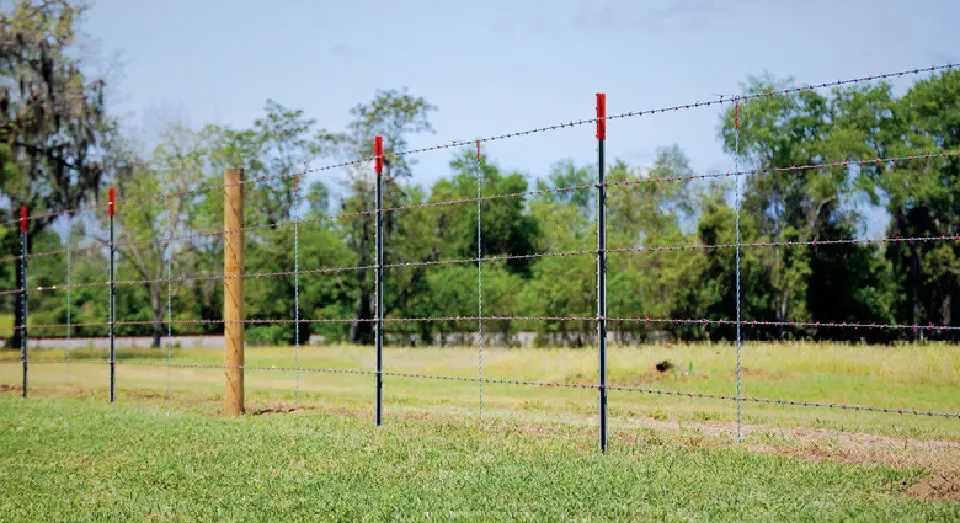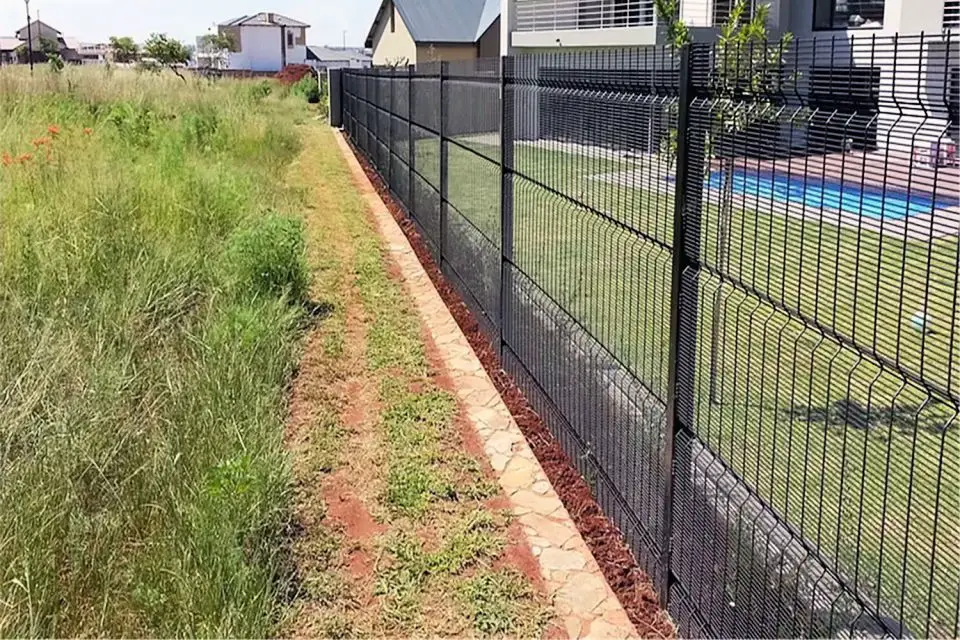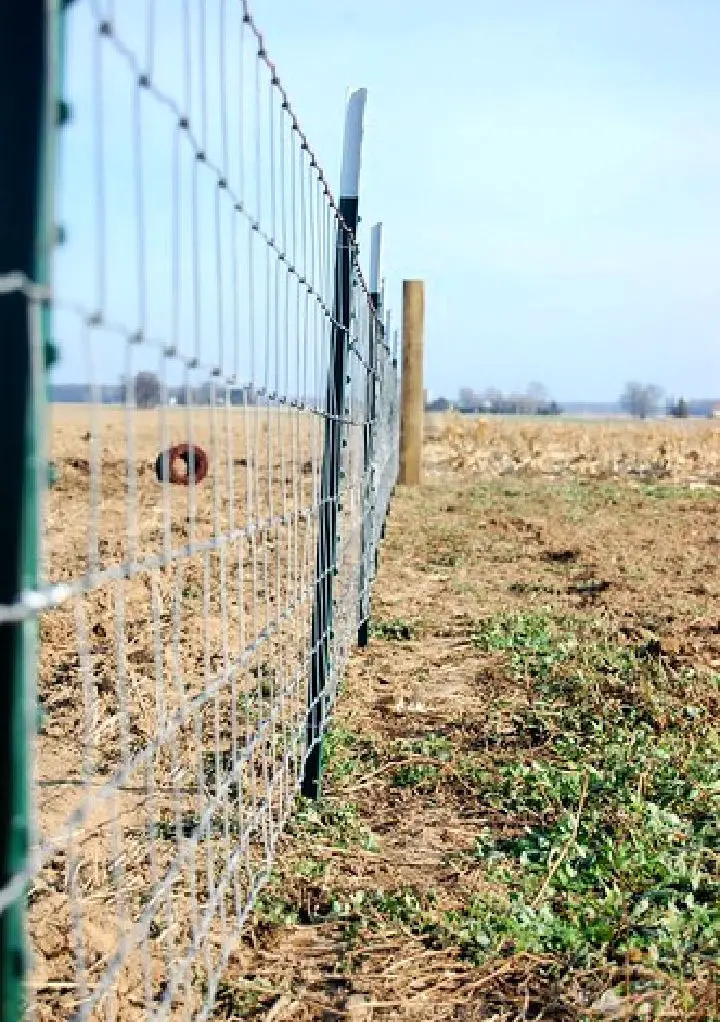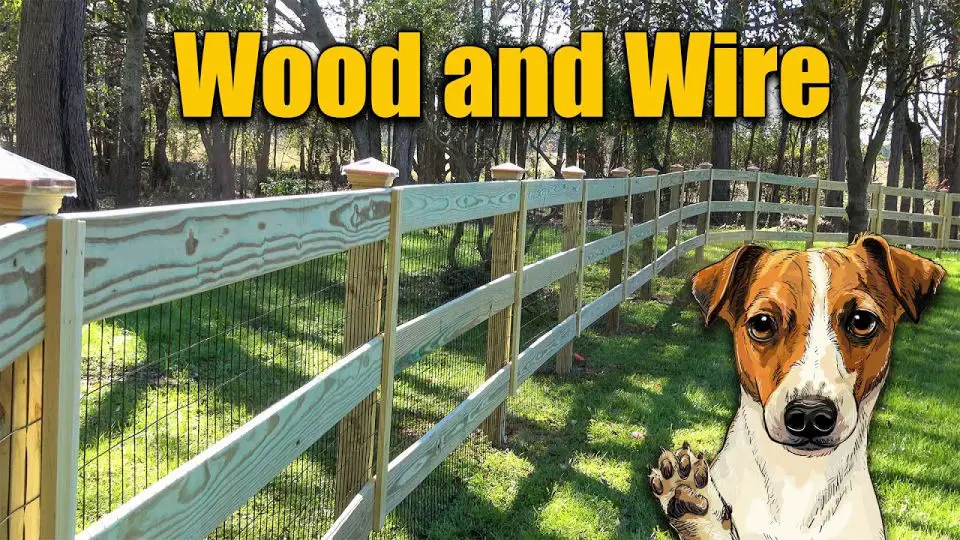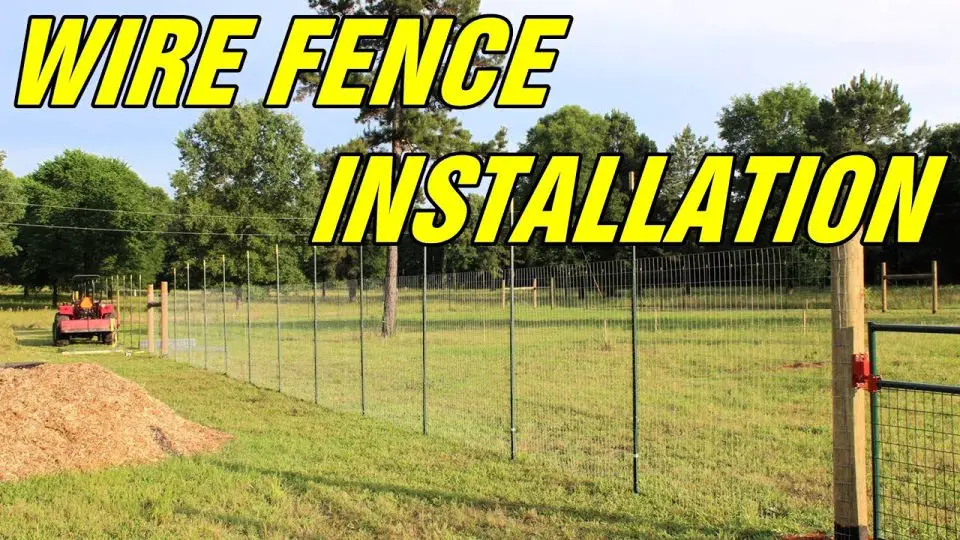How to Build a Hog Wire Garden Fence
As you embark on creating a DIY hog wire garden fence, allow yourself to be captivated by its rustic charm. This type of fencing is particularly well-suited for those who appreciate the aesthetic of cattle or livestock-style barriers. One of the most appealing aspects of this design is the ability to maintain unobstructed views of your garden, which also provides a unique structure for vining plants to thrive. This comprehensive guide will walk you through the process of crafting a simple yet stylish fence using hog wire, perfect for enclosing up to 50 feet of your garden area. With the necessary tools and materials at hand, this project can be completed in just a day or two, all while staying within a budget of under $300. As you customize your fence, consider adjusting the length of fence posts or selecting from various lumber options like redwood, cedar, or pressure-treated lumber. Don’t forget to take into account your local climate when burying the posts. By doing so, you’ll be able to create a fence that seamlessly blends into its surroundings, ultimately unleashing the natural beauty of your garden.
DIY Durable Barbed Wire Fence
When it comes to DIY pasture fencing, barbed wire is an economical and long-lasting option that provides effective containment for cattle in varying terrains. To ensure the durability of your fence, consider robust bracing in low-lying or hilly landscapes, stabilizing and anchoring the fence, and securing the wire at braces with ties. For maximum anchorage, opt for 5-inch diameter posts. In challenging terrain like rocky gullies, innovative solutions such as rock baskets can be employed to create secure anchors. By carefully considering post height and wire spacing based on pasture size and potential pressure, a sturdy barbed-wire fence can play a crucial role in livestock management while preserving the tranquility of your pastoral surroundings.
Installing Wire Fence With T Posts
When it comes to building a robust DIY fence, selecting the right materials and techniques is crucial for longevity. Treated wood and steel t-posts are two popular options for constructing wire fences. This guide delves into the characteristics of t-posts, their recommended weights, and their advantages in terms of strength and durability.To plan your fence installation, you’ll need the right tools and materials. Installing t-posts requires a t-post driver, tape measure, string or wire, come-a-long, wire clips, fence plier or bender tool, and optional fence stays. Post spacing typically ranges from 8 to 12 feet, depending on the type of fence and required support level. Measuring and laying the posts before installation ensures correct spacing and stability.By using t-posts and regular maintenance, you can create a secure and long-lasting animal enclosure. This guide provides valuable tips on post spacing, wire securing, and ensuring overall stability. With these techniques, you’ll be able to build a reliable enclosure for your property.
Building a Wire Fence With Wood Posts
Transforming your property into a secure and visually appealing space is now possible with a DIY welded wire fence. This innovative solution not only safeguards against animals but also keeps pets safe within its boundaries. While installing the fence can be done solo, having a friend or two to assist makes the process more enjoyable and efficient. To match your design aesthetic, choose from wood, metal, or concrete posts. Metal posts offer a sleek, seamless appearance with exceptional durability, while wooden posts provide an easier installation process but require more upkeep. Concrete posts, on the other hand, boast unbeatable strength and longevity. With a wide range of welded wire fence designs, sizes, and colors available, personalization is limitless. The process involves three key steps: measuring and laying out the fence posts, digging and setting the posts, and finally, installing the fencing itself. To ensure a seamless installation experience, always have your tools and materials at the ready before commencing. By planning carefully, selecting the right post materials, and following step-by-step instructions, you can guarantee a successful fencing project. The pride of securing your property with a fence you installed yourself is an unbeatable feeling.
Homemade Welded Wire Fence
Elevate your property’s curb appeal with a stylish and functional DIY welded wire fence that suits various landscapes. The key lies in selecting the right posts – wood, metal, or concrete – each offering unique benefits. Metal posts provide robustness and low maintenance, blending seamlessly with the welded wire to create a sleek appearance. To begin, measure and set your fence posts, then secure the wire fencing to them. Unroll and attach the wire as you go, simplifying the process. With these steps, you’ll be ready to transform your exterior space with a professionally installed-looking fence that’s both secure and aesthetically pleasing.
How to Install Wire Garden Fence
Transform your gardening experience by constructing a DIY fence that safeguards your fruits and vegetables from wildlife and pets. This accessible project demands minimal materials but yields immense satisfaction. To embark on this venture, you’ll need corner wooden fence posts, metal T-posts, wire fencing, a gate, and common tools such as a post digger or auger, hammer, shovel, quick-set concrete mix, fence staples, and wire clips or zip ties.
The process unfolds in four straightforward steps: first, set up the corner posts and T-posts; next, attach your wire fencing; then, secure your gate and hardware cloth; finally, add the finishing touches to complete the project. With its simplicity and adaptability to any skill level or garden size, this DIY endeavor is an excellent way to elevate your gardening experience while adding a touch of elegance to your backyard or garden.
How to Make Woven Wire Fence
Discover how to create a robust DIY woven wire fence to securely contain your livestock, such as sheep. This comprehensive guide delves into the distinct characteristics of welded and woven wire fencing, highlighting its superior performance in long-term fencing applications due to its durable structure and resilience. By following this step-by-step guide, you’ll learn how to plot boundaries, install corner posts, plan for gates, drill post holes, and stretch the fence itself. Additionally, valuable tips on handling materials and avoiding common pitfalls are provided, ensuring your fence is both practical and long-lasting. With insights gathered from hands-on experience, this guide streamlines your fencing project, saving you time and effort.
DIY Welded Wire Fence With Wooden Posts
Elevate your outdoor space with a DIY welded wire fence that’s both functional and cost-effective. With some basic handiwork skills, you can create a sturdy perimeter that suits your needs. Start by gathering the necessary materials: 4×4 posts, 2×4 lumber, deck screws, concrete gravel, welded wire fence rolls, gate hinges, latches, a level, and measuring tools.To begin, accurately measure and stake the post locations to ensure a precise layout. Next, plant your posts, ensuring they’re secure and level before setting them in place with concrete. Once the posts are set, measure and cut 1×4 boards for the top and bottom rails, then secure them in position.Unroll the welded wire fencing and staple it to the rails, making sure it’s level and tightly secured. Finally, measure, build, and attach your gate according to your desired specifications. By breaking down the task into manageable steps, this DIY project becomes accessible to anyone willing to put in the effort. The end result is a secure boundary that not only enhances your outdoor space’s aesthetics but also provides a sense of accomplishment.
Making a Woven Wire Front Yard Fence
Transform your front yard into a secure and visually appealing haven by constructing a durable wire fence that complements your greenery. Perfect for large properties and energetic pets, this affordable and aesthetically pleasing solution provides the perfect balance of security and style.
This comprehensive guide reveals the secret to creating a unique fence that serves its purpose while enhancing the charm of your property without obstructing the view of your surroundings. By harnessing the strength of pressure-treated Ground Contact 4x4s and the flexibility of stretch woven wire, you’ll create a one-of-a-kind barrier that showcases your garden’s beauty.
Discover the detailed instructions, materials required, cost breakdown, and crucial improvement tips to bring your bespoke woven wire/wooden 4×4 fence to life. With this guide, you’ll be well on your way to creating a secure, attractive haven for your home.
Build a Wire Fence With Metal Posts
Creating a modern and minimalist boundary for your outdoor space requires a combination of durable and low-maintenance wire fence ideas. Building a DIY fence that is both attractive and long-lasting demands careful planning, an understanding of various materials and techniques, as well as the ability to navigate different weather conditions. This comprehensive guide will walk you through the process, highlighting key considerations such as post types, support spacing, and fencing material. We’ll explore options like post and board fencing, split-rail fencing, electric fencing, woven wire fencing, and lightweight welded wire fencing, with T-posts and woven wire emerging as top choices. By following this guide, you’ll be equipped to avoid common pitfalls and create a secure, aesthetically pleasing enclosure that meets your needs.
Handmade Wood and Wire Dog Fence
Indulge in the satisfaction of creating a functional and visually stunning dog fence using wood and wire, perfect for securing your furry companions while maintaining the natural beauty of your surroundings. This DIY project is particularly appealing to enthusiasts due to its ease of preparation and construction. The use of readily available and budget-friendly materials like wood and wire makes it an accessible endeavour. By combining the rustic charm of wood with the modern touch of wire, you’ll create a fence that not only keeps your pets safe but also enhances the aesthetic appeal of your outdoor space. Get ready to unleash your creativity and take on this rewarding project today!
How to Install Welded Wire Fence
As you cultivate your vegetable garden, consider embracing the spirit of self-sufficiency by installing DIY welded wire fencing around its perimeter. With the help of a pneumatic narrow crown stapler, you can efficiently secure the fence to the posts, thereby safeguarding your homegrown produce and creating a cozy atmosphere in your outdoor space. This straightforward method is ideal for gardeners of all skill levels, whether tending to a small backyard plot or a larger homestead. The minimal tools and materials required make this project accessible to everyone. By installing DIY welded wire fencing around your vegetable garden, you’ll not only be protecting your crops but also adding a touch of rustic charm to your outdoor oasis. This tutorial serves as a step-by-step guide for those looking to live a more sustainable rural life, where every effort counts towards reaping the rewards of your hard work and dedication.
Easy Wire Fence Installation
If you’re seeking an affordable and reliable way to safeguard your garden or orchard, this comprehensive DIY guide is the perfect starting point. By following our step-by-step video tutorial on wire fence installation, you’ll be able to create a robust barrier that effectively repels unwanted visitors while also enhancing the visual appeal of your property.
To get started, gather essential tools such as fence posts, wire mesh, post driver, and fencing pliers. With these materials at hand, you’ll be well-equipped to construct a durable and easy-to-set-up fence that will provide long-term protection for your plants.
Not only does this type of fencing offer peace of mind by keeping unwanted intruders out, but it also offers a great return on investment. By taking the time to learn the basics of wire fence installation, you’ll be rewarded with a sturdy and attractive perimeter that will serve as a valuable asset for years to come.
Don’t settle for a subpar solution – instead, take the initiative to build a versatile and cost-effective barrier that complements your home’s design. With these wire fence ideas, you’ll be able to create a seamless integration between your outdoor space and your property’s overall aesthetic.
Best Hog Wire Panel Fence Ideas
Transform your outdoor space with eco-friendly wire fence ideas that harmonize safety and aesthetic appeal, suitable for both urban and rural environments. Create a durable, transparent hog wire panel fence that effortlessly navigates sloped yards and unconventional landscapes. This cost-effective DIY endeavor guarantees the well-being of pets and children while preserving scenic views. To ensure accurate installation, you’ll need hog wire panels, fence posts, concrete, and a set of tools including a drill, circular saw, and level.
nThe journey from planning to assembly is a seamless process that culminates in a functional and visually striking outcome. Though the undertaking may require perseverance, the savings of approximately $2,000 make it a worthwhile endeavor.
nThe star of the show – the hog wire – lends robustness and longevity to the structure. Elevate your home’s curb appeal and bask in the peace of mind that comes with this hog wire panel fence project.
How to Install a Welded Wire Fence
Erect a secure and durable net wire fence in your backyard with this step-by-step DIY guide. The comprehensive tutorial will walk you through the installation of a 4-foot tall fence featuring 4-inch gaps, meeting most regions’ pool fencing regulations. This practical barrier not only safeguards against unwanted wildlife incursions but also keeps curious canine companions from chasing after external stimuli.The foundation of the fence is built upon sturdy 5-foot U-posts, ensuring a robust and long-lasting structure. Although this tutorial primarily focuses on setting up a temporary fence until a permanent one can be established, it also addresses adapting the fence angle to varying terrain elevations, making it an adaptable solution for backyards with diverse levels.While this may not be your first choice for aesthetic appeal in the long term, the net wire fence serves its purpose well. The guide further simplifies the process of building a convenient gate, adding functionality and practicality to the overall setup. With this tutorial, you’ll be able to construct a secure, adaptable outdoor space that enhances your home’s exterior. Start building today and take control of your backyard oasis.
How to Stretch Woven Wire Fence
To breathe new life into your woven wire fence, embark on this straightforward DIY adventure. By mastering the right techniques and arming yourself with essential tools, you’ll be able to effortlessly stretch your fencing to optimal levels. This comprehensive guide breaks down the process into manageable steps, ensuring a seamless experience from start to finish.
Leaning on the versatility of common tools like come-alongs, fencing stretchers, and pliers, paired with woven wire or field fence, you’ll be amazed at how effortlessly you can expand the lifespan and boost the visual appeal of your fence. As you work through this step-by-step guide, you’ll discover that a well-stretched woven wire fence is not only durable but also a testament to the care and attention that went into its creation.
With this practical guide, you’ll be empowered to redefine your fencing experience and transform your farm or garden into a serene oasis. So why wait? Dive in today and start redefining the boundaries of your outdoor space.
DIY Barbed Wire Fence – Step-by-Step Instructions
For those venturing into the world of DIY, constructing a crimp-free H-Brace for Stay-Tuff high tensile barbed wire fencing is an essential skill to acquire. This technique, featured in our comprehensive guide on building a robust cattle fence, utilizes Stay-Tuff wire, renowned for its exceptional strength and durability. With the aid of ordinary tools and equipment, you’ll be able to simplify the process of constructing the H-Brace, ensuring a sturdy framework for your fencing project. Beyond just saving costs, this resourceful approach also prioritizes the safety and security of your cattle. By following our step-by-step guide, you’ll gain the satisfaction of building a reliable fence that will provide peace of mind.
DIY Welded Wire Fence Post
Elevate your homesteading experience with a DIY welded wire fence installation that’s both cost-effective and efficient. This comprehensive guide will walk you through the process of setting up a 200ft fence in just seven hours, all while staying within a budget of $430. The result is a sturdy and reliable barrier that not only safeguards your farm animals but also adds a touch of rustic charm to your property.To achieve this, you’ll need a few essential materials, including RedBrand Welded Wire Fence, treated wood posts, studded T-posts, T-post clips, and concrete mix. When it comes to tools, a post hole digger, post driver, and clip bender are crucial for precision and accuracy. With these simple yet effective components, you’ll be well on your way to creating a fence that’s both functional and visually appealing.By installing this welded wire fence, you’ll not only be securing your farm animals but also adding a touch of rural charm to your property. Say goodbye to concerns about livestock getting loose or predators sneaking onto your land, and hello to a sense of peace and tranquility that comes with knowing your property is secure.
Build Your Own Stretch Woven Wire Fence
To create a DIY woven wire fence for your sheep or goat farm without relying on heavy machinery, follow this comprehensive guide. With basic tools and some clever techniques, you can have your 330ft roll fence installed in just a few hours. A key approach is to use a steel pole as leverage, while bungee straps provide extra hands and a wire-tying tool ensures the wire is wrapped tightly. You’ll also learn how to create a DIY stretcher bar using 2x4s and bolts, allowing you to stretch the fence tight without any hassle.
This guide goes beyond just providing installation tips – it also offers essential advice on preserving your H-brace assemblies and suggests optimal spacings to prevent rust and make maintenance a breeze. By following these instructions, you’ll gain the confidence to set up your farm fence securely, giving you peace of mind knowing your livestock are safely contained.
Make Your Own Wire Fence
Discover the thrill of building your fence from scratch with this exhaustive DIY guide. As you navigate the entire process, from designing the initial layout to constructing the final gate, you’ll find that the journey is just as rewarding as the end result. This comprehensive resource provides meticulous instructions on working with mill lumber for cross braces and incorporates attractive welded wire to maintain a charming farm-style aesthetic while ensuring security and animal containment. With the right tools and a clear, step-by-step process, building a fence no longer has to be an overwhelming task. Instead, you can confidently erect your own sturdy, stylish barrier that reflects your personal touch. Start your fencing project today and bask in the pride of having created something with your own hands.
Conclusion:
Mastering the art of constructing wire fences offers a wealth of benefits for homeowners, gardeners, and DIY enthusiasts alike. The sheer variety of designs and ideas, including hog wire garden fences, barbed wire fences, and welded wire fences with wooden posts, provides endless opportunities to create an efficient and attractive barrier that suits your specific needs and preferences. By developing the skills to build, install, and maintain a wire fence, you can effectively boost your property’s security, visual appeal, and overall functionality. With this knowledge at your disposal, why not start building today and unlock the potential to transform your outdoor space?



